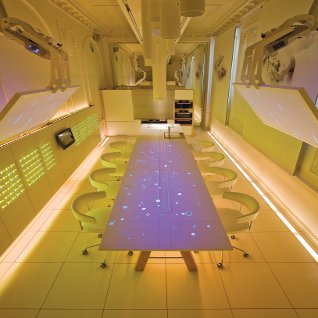Paco Roncero workshop, Milan
A design for the workshop of this leading chef uses the architectural heritage of the space and adds the latest technology to enhance his culinary experimentations
Details
Client:Paco Roncero
Design:Carmen Baselga
Size:58 sq m
Cost:£8.7m
Completion time:12 months
Speaking to Reuters earlier this year Michelinstarred Spanish chef Paco Roncero described the work involved in creating such culinary masterpieces as 'eight texture chocolate'. 'My process starts with a single product - a carrot, an apple, a piece of fish,' he said. 'From there, I try a million methods to change it into something totally new while keeping the essence of its flavour and its being.'
Much like Britain's Heston Blumenthal, Roncero's cooking owes as much to scientific experimentation as it does to culinary tradition, and now, thanks to Spanish design practice Carmen Baselga, he has the perfect place in which to tinker - a specially designed 'workshop' which sits above his restaurant, La Terraza del Casino, in Milan. The idea is that Roncero will invite guests to come and sit round a large rectangular table and sample his newest creations.
Exacting in the cooking and presentation of his 'nouveau cuisine', Roncero was no less fastidious when it came to the design of his workshop. In order to present the food in the best possible way, the chef wanted total control over the atmosphere - the temperature, humidity, lighting, even sound and smell, can all be manipulated at the touch of a button.
The long rectangular room is the perfect size and shape for intimate dining, but the designers say there was plenty of work to do to make it fit for purpose. 'At the beginning [of the project] we found a space that dated back to 1910, but very damaged and with old, though not antique, floors that had replaced the timber ones,' says Baselga. Some of the room's original decorative moulding was chipped and broken and much of the ceiling and walls were stippled with paint, so the first job was restoring the room to its former glory.
'The aim was to create a big white box that kept the character of its time,' says Baselga. Modern, bespoke furniture was used to create a strong contrast between the space's history and its new, very modern, purpose.
In the centre of the space is a large worktopcum- dining table whose flawless surface of Keraon (a highly durable material made by Tau Cerámica) hides some very clever technology. As well as having its own gas burners and water supply, the table also has capacitive sensors which automatically control the temperature of the surface and nine individually heated areas for plate warming.
Finding the perfect chairs was something of a challenge, says Baselga. The fact that the table was to be used as a worktop for food preparation meant it had to be 97cm high, while the standard height for a dining chair is 91cm. The chairs had to be either custom-made or adjustable, but they also had to be comfortable enough to eat from and for after-dinner conversation.
'An essential requirement was that they had to be of adjustable height, swivel and have wheels to allow full mobility,' says Baselga. She settled on a specially modified version of the Tauro chair by Andreu World that she describes as 'a hybrid of an office chair, dining chair and armchair'.
Anyone who knows anything about Roncero will instantly identify the contents of 216 backlit test tubes that jut out of a TAU Cerámica DrySystem feature wall. They contain the chef's signature ingredient, the finest Spanish olive oil, of which he has said: 'There is nothing better in this world'.
The display wall, like the table, is made of Keraon and has bright and matt surfaces, into which numbers and letters are engraved to identify each type of oil. A touch screen in the centre of the wall provides more information.
Above the table, several tubes made of lacquered steel conceal lighting, projectors, cameras, scent diffusers and an extraction system. There are also two robot arms, used to position projector screens, dramatically changing the look and feel of the space.
Roncero uses a battery of specialist kitchen equipment in his kitchen, but his most sophisticated tools are, of course, his hands. As a reminder of this, Baselga applied large-scale graphics of the chef's hands to the white walls of the dining space.
If you can call Roncero a chef, a scientist or even an artist, then you can certainly call him a designer too, and his creative input on this project is everywhere to be seen. Baselga's designers themselves say that one of the keys to the success of the project was the clear communication and understanding between the chef and themselves.
'Paco Roncero is a very creative person with great attention to detail,' says Baselga. 'He transmits this through his work, his culinary creations, but he is also able to clearly communicate his ideas verbally. 'He had a dream,' she continues, 'and we helped him turn it into reality.'
This article was first published in fx Magazine.












